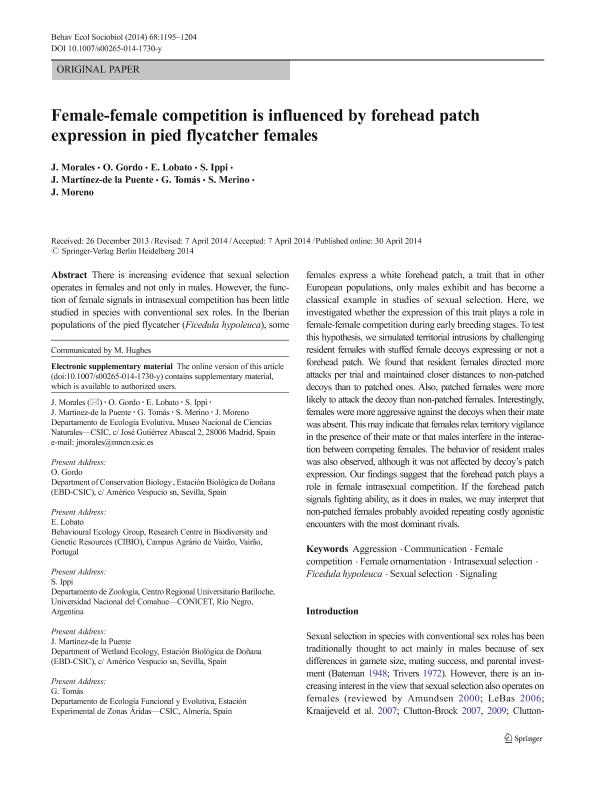Mostrar el registro sencillo del ítem
dc.contributor.author
Morales, J.
dc.contributor.author
Gordo, O.
dc.contributor.author
Lobato, E.
dc.contributor.author
Ippi, Silvina Graciela

dc.contributor.author
Martínez de la Puente, J.
dc.contributor.author
Tomás, G.
dc.contributor.author
Merino, S.
dc.contributor.author
Moreno, J.
dc.date.available
2022-12-07T14:15:06Z
dc.date.issued
2014-06
dc.identifier.citation
Morales, J.; Gordo, O.; Lobato, E.; Ippi, Silvina Graciela; Martínez de la Puente, J.; et al.; Female-female competition is influenced by forehead patch expression in pied flycatcher females; Springer; Behavioral Ecology And Sociobiology; 68; 7; 6-2014; 1195-1204
dc.identifier.issn
0340-5443
dc.identifier.uri
http://hdl.handle.net/11336/180518
dc.description.abstract
There is increasing evidence that sexual selection operates in females and not only in males. However, the function of female signals in intrasexual competition has been little studied in species with conventional sex roles. In the Iberian populations of the pied flycatcher (Ficedula hypoleuca), some females express a white forehead patch, a trait that in other European populations, only males exhibit and has become a classical example in studies of sexual selection. Here, we investigated whether the expression of this trait plays a role in female-female competition during early breeding stages. To test this hypothesis, we simulated territorial intrusions by challenging resident females with stuffed female decoys expressing or not a forehead patch. We found that resident females directed more attacks per trial and maintained closer distances to non-patched decoys than to patched ones. Also, patched females were more likely to attack the decoy than non-patched females. Interestingly, females were more aggressive against the decoys when their mate was absent. This may indicate that females relax territory vigilance in the presence of their mate or that males interfere in the interaction between competing females. The behavior of resident males was also observed, although it was not affected by decoy's patch expression. Our findings suggest that the forehead patch plays a role in female intrasexual competition. If the forehead patch signals fighting ability, as it does in males, we may interpret that non-patched females probably avoided repeating costly agonistic encounters with the most dominant rivals.
dc.format
application/pdf
dc.language.iso
eng
dc.publisher
Springer

dc.rights
info:eu-repo/semantics/openAccess
dc.rights.uri
https://creativecommons.org/licenses/by-nc-sa/2.5/ar/
dc.subject
AGGRESSION
dc.subject
COMMUNICATION
dc.subject
FEMALE COMPETITION
dc.subject
FEMALE ORNAMENTATION
dc.subject
FICEDULA HYPOLEUCA
dc.subject
INTRASEXUAL SELECTION
dc.subject
SEXUAL SELECTION
dc.subject
SIGNALING
dc.subject.classification
Zoología, Ornitología, Entomología, Etología

dc.subject.classification
Ciencias Biológicas

dc.subject.classification
CIENCIAS NATURALES Y EXACTAS

dc.title
Female-female competition is influenced by forehead patch expression in pied flycatcher females
dc.type
info:eu-repo/semantics/article
dc.type
info:ar-repo/semantics/artículo
dc.type
info:eu-repo/semantics/publishedVersion
dc.date.updated
2022-12-06T17:15:53Z
dc.journal.volume
68
dc.journal.number
7
dc.journal.pagination
1195-1204
dc.journal.pais
Alemania

dc.journal.ciudad
Berlin
dc.description.fil
Fil: Morales, J.. Consejo Superior de Investigaciones Científicas. Museo Nacional de Ciencias Naturales; España
dc.description.fil
Fil: Gordo, O.. Consejo Superior de Investigaciones Científicas. Museo Nacional de Ciencias Naturales; España. Consejo Superior de Investigaciones Científicas. Estación Biológica de Doñana; España
dc.description.fil
Fil: Lobato, E.. Consejo Superior de Investigaciones Científicas. Museo Nacional de Ciencias Naturales; España. Cibio - Centro de Investigação Em Biodiversidade E Recursos Genéticos; Portugal
dc.description.fil
Fil: Ippi, Silvina Graciela. Universidad Nacional del Comahue. Centro Reg.universidad Bariloche. Departamento de Zoología. Cátedra de Vertebrados; Argentina. Consejo Nacional de Investigaciones Científicas y Técnicas. Centro Científico Tecnológico Conicet - Patagonia Norte; Argentina
dc.description.fil
Fil: Martínez de la Puente, J.. Consejo Superior de Investigaciones Científicas. Museo Nacional de Ciencias Naturales; España. Consejo Superior de Investigaciones Científicas. Estación Biológica de Doñana; España
dc.description.fil
Fil: Tomás, G.. Consejo Superior de Investigaciones Científicas. Museo Nacional de Ciencias Naturales; España
dc.description.fil
Fil: Merino, S.. Consejo Superior de Investigaciones Científicas. Museo Nacional de Ciencias Naturales; España
dc.description.fil
Fil: Moreno, J.. Consejo Superior de Investigaciones Científicas. Museo Nacional de Ciencias Naturales; España
dc.journal.title
Behavioral Ecology And Sociobiology

dc.relation.alternativeid
info:eu-repo/semantics/altIdentifier/doi/http://dx.doi.org/10.1007/s00265-014-1730-y
Archivos asociados
